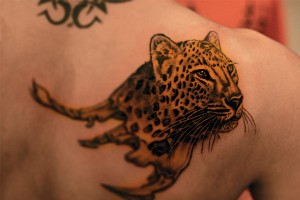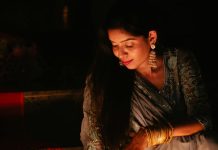Indian culture is changing and evolving constantly. Traditionally, tattoos and mehendi have been around as a core part of our traditions. Today, people are becoming more fashion conscious. Modern-day tattoos are an important aspect of Western culture; sometimes as a form expressing your bold attitude, a way of showing someone you love them or even simply a design to remind you of something important. A 69-year-old woman in Mumbai, Kaanta Shah, is comfortable enough with the trend to get a tattoo on her skin of Durga Ma, fulfilling a long-standing desire to have the deity be part of her in some way. The tattooing trend is even having an impact in the corporate world; even GMs of well-known hotel companies and CEOs are getting tattoos today. People who earlier would have had a social stigma attached to getting a tattoo now see it for the freedom of expression it really is.
Although tattoo parlours now abound in India, the well-known tattoo artists based in metro cities are not too pleased with the trend. After the tattoo industry in India received intensive media attention in the late 90s, people began to order the tools online and ‘ink’ people. However, most only learned the technique of making tattoos but not the creative skills required. To make it in this industry, one needs to know more than how to simply mix paints and draw; they need passion for the art, a vivid imagination, patience and an understanding of the human psyche.
Sameer Patange was an early pioneer in the game, featured in the Limca Book of Records as the youngest tattoo artist in India at the age of 20. For Patange, who has made a name for himself in the Bollywood industry and has inked stars such as Hrithik and Suzanne Roshan, Sushmita Sen, Ajay Devgan, Sanjay Dutt, Riya Sen and Neil Nitin Mukesh, business is booming. Patange is quite candid about the dark nature of tattooing. As a musician in the 90s, tattoos, parties and drugs went hand in hand. He began to make tattoo drawings for his friends and came under the radar of Dr A J Kohiyar, the father of modern tattooing in India. Dr Kohiyar was a psychologist and a therapist who trained in London and learned his techniques there. He felt that tattoos were an expression of the individual’s internal psyche, and it was the job of the artist to find the image that best represents the psyche of the individual he or she is inking. He was the first person to introduce tattoo equipment and processes in the city.
Dr Kohiyar advocated tattooing as an art form – he got his early designs from students at the JJ School of Art. Today, however, the scenario is such that people are picking up machines and making tattoos. Copying crude images from the Internet is commonplace in this scenario, but true artists always make their own drawings to fit in with their client’s requirements. It’s all about visualising skills and creativity. Patange says, “Tattooing is all about catering to people’s vision. They come to us because they think that we can foresee what they can’t.”
Customising each design to the client is a lengthy process that requires a lot of patience. A lot of people want to get a tattoo but are very confused about what they should get. For example, some individuals want to have text tattoos but are not sure about what they want – they sometimes come to the artist for advice. Patange laughs and says, “I am tempted to say that you should get ‘I am an idiot’ tattooed on yourself.” However, he clarifies, as a tattoo artist, one needs to have a lot of patience to put up with a lot difficult people. He explains his process, saying, “About 70 per cent of people are blank about what they want to get done. So you start showing them designs blindly. Somehow, based on their responses, you figure out what they like and what are their inclinations. After that you can begin guiding them. At some place, you reach a point where your ideas match theirs.”
Savio D’Silva, an independent tattoo artist and graphic designer, says a prerequisite for making tattoos is that one should have an art and design background. Tattooing today has become mere ‘tracing’ or ‘scratching’ after learning the essential techniques, as it is a lucrative industry to be in. Beginners can easily make up to Rs. 25,000 per month, while for well-known artists, the sky is the limit. However, there is a theory to the art and a lot of people take on apprentices and teach you how to fuse the equipment without teaching the basics of art.
D’Silva says, “The tattoo industry is like a dot com boom. Everyone is getting into it without the necessary qualifications. For some people, just like mehendi artists, their strokes get better over years. Yet, they don’t have a sense of design or proportion. Some tattoo figures have twisted fingers, elongated necks and so on. I think if you don’t have an art background, then you don’t have an eye for good work and bad work; you don’t even realise what is good and bad. It’s the same scene abroad, in that there are artists and there are stencil drawers. If an artist tattoos, the level of tattooing will change.”
If you are interested in tattooing as a career, you need to have an artist’s mindset, creativity and skill. D’Silva elaborates, “I come from a creative background – I was sculpting and painting since an early age and I have been an illustrator for over 15 years. I am more interested in making good tattoos than making money. My clients are few and mature enough to understand that my work is focused on quality and appreciate the art behind it. I sometimes charge double and triple of commercial rates, depending on the design. I select my clients and work very slowly compared to others. Some designs take me up to a week. In time, I want to start a design studio and start making tattoos as fine art.” Interstingly, D’Silva does not have a single tattoo on him. He says, “For me, the skin is an extension of my canvas.”
What about the educational scene? D’silva says, “These tattoo courses are total rubbish – the people teaching don’t know how to draw. Most of them have learned through renowned artists for free and now charge other people to learn. These guys are not art literate at all. If the person is not an artist, then they have no artistic integrity and should not learn how to make tattoos.”
If one is serious about making tattoos, then the best way to learn is to become an apprentice with a well-known tattoo artist and build one’s experience. D’Silva thinks there should be a basic set of requirements for apprentices in the industry; “I make sure that their line quality is good, that they have strong figurative style and good sense of proportion. My only hope is to get artists from JJ as Dr Kohiyar originally did. The standard of tattooing in India will go up again to a fine art level.” We can only hope!
TATTOO COURSES:
NEEDLE ART, MUMBAI – www.tattoosmumbai.com
Cost: Rs. 15,000
RIP TATTOOS, DELHI – www.riptattoos.in
Cost: Rs. 50,000 to 75,000
INKTRIBE, PUNE – www.inktribe.in
Cost: Rs. 100,000
Volume 1 issue 4































